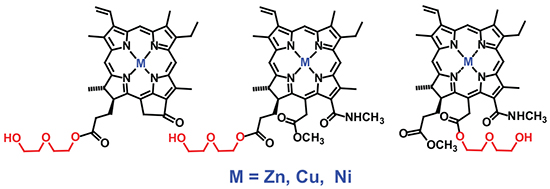Журнал "Макрогетероциклы"
Navigation
News
Impact Factor 2021 = 1.200 has been issued by ISI Web of Knowledge (JCR 2021).
Search
ISSN 1998-9539
Synthesis and Cytotoxic Activity of Transition Metal Porphyrinates with a Fragment of Diethylene Glycol on the Periphery of the Macrocycle
Y. I. Pylina,a O. M. Startseva,b E. E. Rasova,a and D. V. Belykhb@
aInstitute of Biology of Komi Scientific Centre of the Ural Branch of the Russian Academy of Sciences, 167982 Syktyvkar, Russia
bInstitute of Сhemistry of Komi Scientific Centre of the Ural Branch of the Russian Academy of Sciences, 167000 Syktyvkar, Russia
@Corresponding author E-mail: belykh-dv@chemi.komisc.ru, belykh-dv@mail.ru
DOI: 10.6060/mhc181219b
Macroheterocycles 2019 12(2) 165-170
A number of new transition metal porphyrinates based on chlorophyll a derivatives with diethylene glycol fragments at the chlorin macrocycle periphery were synthesized, and the influence of the position of the diethylene glycol fragment, as well as of the presence and nature of the coordinated metal cation (Cu2+, Zn2+, Ni2+) on the cytotoxic activity of chlorophyll a derivatives against HeLa cells was studied. The main tendencies of metal influence on cytotoxic properties are that the introduction of the zinc cation significantly increases cytotoxicity going from low-toxic metal-free chlorins to the corresponding complexes and has little effect in the case of relatively toxic chlorins, and the introduction of the nickel and copper cations hardly alters or slightly reduces the cytotoxic effect. The exception is pyropheophorbide a diethylene glycol ether, which is significantly less cytotoxic than the corresponding copper porphyrinate. The insertion of the diethylene glycol fragment increases cytotoxicity in the case of copper porphyrinates, and in the case of zinc and nickel porphyrinates the cytotoxic properties slightly change. The complexes based on chlorophyll a derivatives without exocycle have the greatest cytotoxic activity, as well as zinc porphyrinate based on pyropheophorbide a diethylene glycol ether. Among these complexes nickel porphyrinate based on a 13-methylamide chlorin e6 derivative with a fragment of diethylene glycol in position 17 of the macrocycle has the greatest cytotoxicity. All of these derivatives are of interest from the point of view of a more detailed study as potential dark antitumor cytotoxic agents.

| Attachment | Size |
|---|---|
| mhc181219b.pdf | 564.73 KB |
- 1163 reads
- Русский
